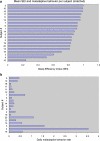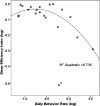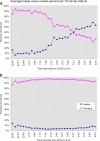Maladaptive behaviors are linked with inefficient sleep in individuals with developmental disabilities
- PMID: 20700513
- PMCID: PMC2914862
- DOI: 10.1007/s11689-010-9048-1
Maladaptive behaviors are linked with inefficient sleep in individuals with developmental disabilities
Abstract
The purpose of the current study was to assess the relations between nightly sleep patterns and the frequency of daily maladaptive behavior. Antecedent and consequential relations between sleep patterns and behavior were evaluated with time series analysis. Sleep efficiency and maladaptive behavior were determined for 20 female residents of an institutional care facility for adults with developmental disabilities. Daily maladaptive behavioral data and nightly sleep/awake logs were collected for 4 months for each participant. Efficient sleep patterns were significantly associated with lower frequencies of maladaptive behaviors. All lagged cross-correlations 8 days before and 8 days after an evening of sleep were significant. These findings suggested that inefficient sleep was associated with increased maladaptive behaviors and that the lagged associations reflected a chronic but not an acute linkage between sleep and behavior.
Figures



Similar articles
-
A daily diary study on maladaptive daydreaming, mind wandering, and sleep disturbances: Examining within-person and between-persons relations.PLoS One. 2019 Nov 27;14(11):e0225529. doi: 10.1371/journal.pone.0225529. eCollection 2019. PLoS One. 2019. PMID: 31774836 Free PMC article.
-
Stability and longitudinal association between Body Mass Index and maladaptive eating behaviors in older adults: Results from the NutriAct Family Study (NFS).Eat Behav. 2023 Aug;50:101778. doi: 10.1016/j.eatbeh.2023.101778. Epub 2023 Jun 29. Eat Behav. 2023. PMID: 37421906
-
Daily dynamics in sleep and behavior of young African-American children: A convoluted dyad?!Int J Psychophysiol. 2016 Jan;99:57-66. doi: 10.1016/j.ijpsycho.2015.11.003. Epub 2015 Nov 6. Int J Psychophysiol. 2016. PMID: 26548618
-
Nightly sleep-wake concordance and daily marital interactions.Sleep Health. 2021 Apr;7(2):266-272. doi: 10.1016/j.sleh.2020.11.003. Epub 2021 Jan 11. Sleep Health. 2021. PMID: 33446469 Free PMC article.
-
Care of Adults With Intellectual and Developmental Disabilities: Developmental Disabilities.FP Essent. 2015 Dec;439:11-9. FP Essent. 2015. PMID: 26669210 Review.
Cited by
-
Interventions for sleep difficulties in adults with an intellectual disability: a systematic review.J Intellect Disabil Res. 2019 May;63(5):372-385. doi: 10.1111/jir.12587. Epub 2019 Jan 9. J Intellect Disabil Res. 2019. PMID: 30628125 Free PMC article.
-
Behavioral assessment and faded bedtime intervention for delayed sleep-onset in an adult with autism spectrum disorder.Int J Dev Disabil. 2021 Jan 11;68(5):624-632. doi: 10.1080/20473869.2020.1855692. eCollection 2022. Int J Dev Disabil. 2021. PMID: 36210902 Free PMC article.
-
Trajectories of diurnal cortisol in mothers of children with autism and other developmental disabilities: relations to health and mental health.J Autism Dev Disord. 2013 Oct;43(10):2426-34. doi: 10.1007/s10803-013-1791-1. J Autism Dev Disord. 2013. PMID: 23468069 Free PMC article.
References
-
- Carr EG, Neumann JK. Graphic sleep monitoring: a clinical program to improve sleep in residents with mental retardation. J Dev Phys Disabil. 1999;11(2):91–103. doi: 10.1023/A:1021838902763. - DOI
-
- Couturier JL, Speechley KN, Steele M, Norman R, Stringer B, Nicolson R. Parental perception of sleep problems in children of normal intelligence with pervasive developmental disorders: prevalence, severity, and pattern. J Am Acad Child Adolesc Psychiatry. 2005;44(8):815–22. doi: 10.1097/01.chi.0000166377.22651.87. - DOI - PubMed
